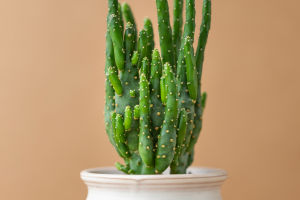Succulents are a class of plants with strong water storage capacity, and they usually have thick, plump leaves or stems to adapt to arid or semi-arid environments. Succulents are mostly distributed in tropical and subtropical regions, but some species can adapt to temperate climates.
Succulents have a very rich shape and color, including spherical, cylindrical, clustered, hanging, climbing, upside down, and other growth forms. Their leaves are also in various shapes, such as round, oval, triangular, heart-shaped, sword-shaped, etc., and the colors are also different, such as red, green, gray, blue, purple, etc.
Because succulents are relatively easy to maintain and have high ornamental value, they have become of very popular potted plants in recent years. They can be found in various places such as homes, offices, and gardens.
At the same time, succulents are also used in landscape design and greening construction, playing a role in beautifying the environment.
Here are some basic steps and tips for growing succulents:
1. Choose the right soil and container. Succulents need airy, well-drained soil and containers. You can choose soil specifically designed for succulents or make your own, which usually involves mixing loose materials such as sand, perlite, and leaf mold.
2. Provide sufficient sunlight to succulents. Succulents like plenty of sunlight, but are prone to sunburn in the hot sun, so care needs to be taken to avoid direct exposure. It can be placed in a sunny but shaded location.
3. Water regularly. Succulents need regular watering, but care needs to be taken not to overwater, which can lead to root rot. Generally speaking, succulents need to be watered after the soil is completely dry.
4. Timely fertilization. Succulents don't need a lot of nutrients, so fertilizers can be applied in moderation. You can choose a special fertilizer suitable for succulents, or you can make your own fertilizer.
5. Pay attention to temperature and humidity. Succulents like a warm and dry environment, but you need to pay attention to keeping the indoor temperature above 5°C in winter, otherwise it will affect the growth and health of the plants.
6. Pay attention to insect and disease prevention. Succulents are vulnerable to pests and germs, so it is necessary to check the plants regularly for pests or germs and take corresponding control measures.
In short, you need to pay attention to the above basic steps and skills in cultivating succulents, but different varieties of succulents may have different breeding requirements, which need to be adjusted and practiced according to specific conditions.
Succulents are easier to maintain than other plants. They can adapt to both indoor and outdoor environments, don't require much water and fertilizer, and are less susceptible to pests and diseases.
Succulents can absorb carbon dioxide in the air and release oxygen to purify the air. In the hot summer months, succulents can also act as a cooling effect, bringing coolness to indoor or outdoor environments.
Growing succulents can also help relieve negative emotions such as stress, anxiety, and depression, and improve mental health. At the same time, taking care of succulents can also cultivate patience and caring qualities, and enhance self-confidence and a sense of accomplishment.
Growing succulents not only adds to the joy of life but also benefits the environment and your health.


